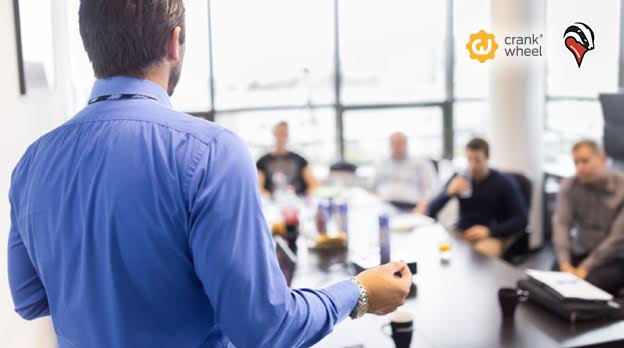Online or On-Site. What’s Best For Your Sales Presentation?
For a long time there’s been an intense debate between onsite and online sales presentations. Is it better for your team to be in the field, meeting customers face-to-face? Or putting them on the phones, calling and presenting demos online?
The wrong choice can cost your company a low closing rate and fail to turn your prospects into customers. That’s why it’s an absolute necessity to consider the strengths and weaknesses of each option when choosing a sales presentation method.
What are the advantage of online demos over on-site? What’s best for your business? That’s what you’ll find out in this article.
Online Demos = Time Efficiency

From a company’s standpoint, online demos are a huge advantage in saving time lost to reps traveling from place to place. It’s time-consuming for your sales force to prepare for their meeting, avoid traffic, introduce themselves to the team etc. All these steps are time lost for reps that could easily be solved by an online demo.
And it’s the same from a customer’s point of view. As a company, you should always have your customer’s time in mind. It takes time for them to travel, book meeting rooms, swap greetings, and perform the demo itself - making on-site presentations time-consuming.
Online demos, on the other hand, are more convenient to schedule and a great method to increase productivity since the whole process is internal.
In-Person Demos Help with Retention?
Every customer should go through a retention stage to harden your relationship with them. It is also a way to sell your product in person and generate more revenue from the interaction. Demos are a good way to communicate the value of your product/service during this process. Although, are online demos better at convincing your customer to buy your product than in-person field sales? It depends on your client.

From the perspective of your sales process, on-site presentations mean your customer is more involved in the buying process. Real interaction between sales reps and prospects creates a higher level of engagement with your product. Thus, the ROI of an in-person demo can be more attractive, despite the higher cost. Moreover, your customers might appreciate the extra-time you take to travel and visit them. Remember to never underestimate the power of making people feel special. The question you should now start asking is: For which customers is it worth spending this extra time?
On the contrary, not every customer appreciates interacting with a salesperson. Younger generations usually avoid face-to-face contact with salespeople and prefer to interact via email or text. To build a relationship with these customers, try using their favorite communication interface. When it’s time to present your software through a demo, it’s more likely that they’ll prefer an online one.
The Weight of Nonverbal Communication in Sales
Approximately 65% of communication is nonverbal, which includes facial expressions, tone of voice, gestures, posture, clothing, eye contact etc. As an example, talking to a sales rep on the phone who sounds enthusiastic and genuine is important in the customer decision’s to buy or not.
That is why an online presentation using a screenshare and your voice are always better to transmit value to a pitch than salespeople using only their the phone. Your audience will be able to capture more of the nonverbal communication to make your point across.

However, nonverbal communication can hurt a sale if the rep makes a bad impression. In business, appearance can make or break your presentation. And a rep with bad communication skills will only muddle its audience. For an on-site presentation your employees must be experts in public speaking. It’s something that you don’t have to worry about as much with online demos since appearance is often restricted to voice.
Relationship Building
Sales managers tend to think that on-site demos are the most effective ways to connect with customers. Online demos, on the other hand, are effective since nothing is distracting your customer from the product. It lets them focus on what matters: Your presentation.
For online demos, the best sales reps are the ones that listen to their customers and know how to bound over what they’ve heard. However, this gift is not given to everyone. It requires skill and experience to connect with customers in a short period of time.
Another key to building stronger customer relationships is to keep track of who has touched base with which customer. Keeping contact with the same customers is better to avoid mistakes and create intimacy. Your reps should remember the customers they talked to and keep track of each interaction. This way, your customer won’t have to explain their situation again to a different person. Building this relationship requires talent from your reps.
Online Demos As International As You Want
Online demos are now so widespread for a very simple reason. More important than the time saved or its efficiency, your customer can watch your demo anywhere in the world. Whether your customer is next door or on another continent, you’ll always have the possibility to do your sales presentation. On the contrary, on-site sales are limited by your ability to travel to your customers.
The internet isn’t limited by geography, you can communicate with customers anywhere as long as you have an internet connection or a phone. The only limit to your online presentation is the time difference between you and your customer’s time zone.
The key takeaway is that a company might not want to rely exclusively on online or field sales demos. Each client has specific needs and you should spend time accordingly. Is your client so important that you feel you should meet him and give the presentation yourself? Or would it be more efficient to give him a quick call from your desk to do a demo? These are the questions you should ask yourself to implement your solution.
No matter how you present to your clients, making them feel like they’ve got the full support they deserve is what’s most important. Your sales rep is the difference between a lost prospect and a future customer.
About the Author: Lucas Ricolleau is an Account Manager at Badger Maps. Badger is a sales routing tool that helps field salespeople be more successful. It integrates with a CRM and visualizes the customer data on a map. With Badger, reps save time and gain focus, spending less time on driving and busy work and more time on selling. You can follow Lucas and his team on Facebook and Twitter @BadgerMaps.
